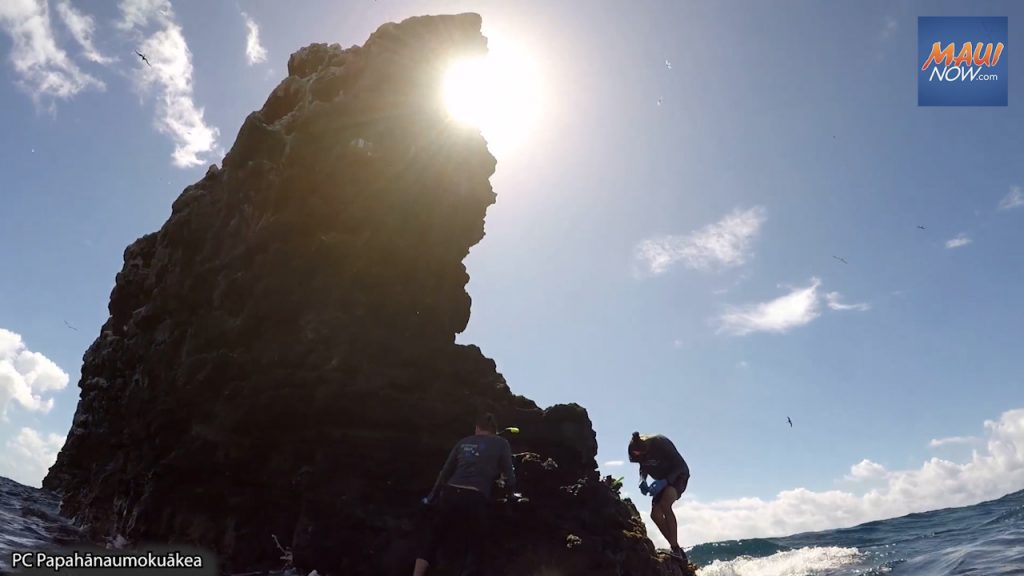Native Hawaiian Scientists Depart for Papahānaumokuākea

A group of 12 Native Hawaiian researchers will depart from Kāneʻohe Bay on Saturday to embark on a 15-day scientific voyage into the Papahānaumokuākea Marine National Monument that is supported in part by the Office of Hawaiian Affairs.
Researchers will sail aboard the Makani ʻOlu, a 96-foot, triple-masted schooner, as they visit the most eastern islands in the monument: Nihoa, Mokumanamana and Lalo (French Frigate Shoals).
“OHA is proud to support some of the most brilliant scientific minds of our lāhui, whose research in the kūpuna islands in Papahānaumokuākea will help us create better management strategies to deal with climate change and sea level rise affecting our communities here in the younger islands,” said OHA Board Chair Carmen “Hulu” Lindsey. “As a Co-Trustee of the monument, OHA is excited to promote projects that demonstrate for the entirety of our history as people stretching as far back to our ancestors’ discovery of this archipelago, there has never been a separation between our culture and science. These researchers are following in the footsteps of our kūpuna as they use our native language, traditional protocols, and cultural worldview to pursue a better understanding of our environment and develop new methods to help us survive in our island home.”

The hui will be collaborating on two separate scientific studies on sea-level rise and intertidal fisheries management, working alongside each other during field work and expanding on future cross-collaborations. Led by Haunani Kāne, an assistant professor at the Center for Global Discovery and Conservation Science at Arizona State University, the first study will identify shifts in dominant sediment types and its sources from the nearshore reefs at Lalo.
In 2018, Hurricane Walaka devastated this area and resulted in the loss of an entire islet and large expanses of pristine reef. The study seeks to improve our understanding of the potential loss and timescales for recovery of critical habitat following extreme storm events. It will also focus on learning more about how the predicted increased sea level rise and hurricane activity in Hawaiʻi will impact essential habitats for priority species, such as sea turtles, monk seals, and various seabirds.
This project is also supported by the National Fish and Wildlife Foundation, the National Science Foundation and Arizona State University.
“We hope that our trip will help to inspire other Native Hawaiians to push the boundaries of Hawaiian perspectives in their field, even when they feel like their voice is the minority,” Kāne said. “This will be the first time that an entire crew of Hawaiian scientists will lead research in Papahānaumokuākea under a research permit and our research will directly contribute to four Native Hawaiian graduate degrees and an early career professor.”
The second study will be conducted by Nā Maka Onaona in partnership with the University of Hawaiʻi-Mānoa and UH Sea Grant to build on more than a decade of partnerships with various organizations and communities monitoring the dynamic Hawaiian intertidal fishery in the main Hawaiian Islands and Papahānaumokuākea. Led by Pelika Andrade and Kanoeʻulalani Morishige, the research will develop sustainable harvesting and adaptive management strategies that support ʻāina momona, healthy and productive communities of people and place. One of the ancestral knowledge systems integrated into the project is the use of Huli ʻIa, a traditional observational process that documents seasonal changes and shifts across entire landscapes.
“Paired with Huli ʻIa, we interweave community engagement, ancestral knowledge systems, and institutional research, creating a unique research approach called Productivity and Carrying Capacity (PACC) to better understand seasonal changes on patterns of reproduction, recruitment, growth, and productivity of ʻopihi and intertidal ecosystems,” said Morishige, a UH-Mānoa Marine Biology PhD candidate. “Our work across the pae ʻāina, including Papahānaumokuākea, broadens our understanding and collectively informs our research on the breadth and depth of productive systems andʻāina.”
OHA’s support of this cultural and scientific voyage aligns with Mai Ka Pō Mai, a groundbreaking guidance document recently approved by the Papahānaumokuākea Management Board that uses traditional concepts and cultural traditions related to the monument to set a foundation for how management should be conducted.
Papahānaumokuākea is cooperatively managed to ensure ecological integrity and achieve strong, long-term protection and perpetuation of Northwestern Hawaiian Island ecosystems, Native Hawaiian culture, and heritage resources for current and future generations. Four co-trustees – the Department of Commerce, Department of the Interior, State of Hawai‘i and the Office of Hawaiian Affairs – protect this special place. Papahānaumokuākea Marine National Monument was inscribed as the first mixed (natural and cultural) UNESCO World Heritage Site in the United States in July 2010.



































